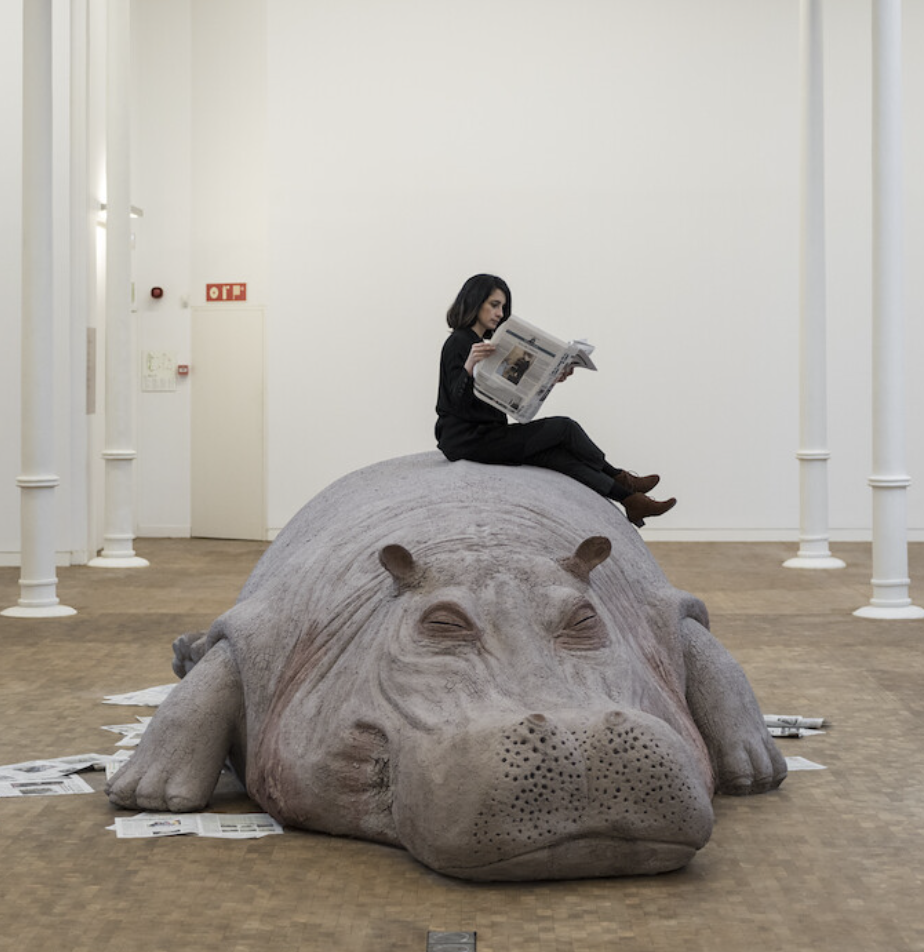With artwork consisting of sculptures, installations, and performances, Puerto Rico based artists Jennifer Allora and Guillermo Calzadilla have taken over Europe with art that they themselves would describe as, “massive. And ugly. And obnoxious.”
Since meeting at art school in Florence, Italy, Allora and Calzadilla have exhibited several thought-provoking and often obscure installations that focus on socio-political themes. They use research-based methods to produce art that reflects history and politics, making bold statements using even bigger and bolder sculptures.
Albeit ugly and obnoxious, their work so elegantly confronts American imperialism and notions of the country’s exceptionalism. By rejecting the normative attitudes towards aspects of American history and nationalism they challenge the developed world to build relations with its developing counterpart, and in doing so they speak to the United Nations Sustainable Development Goals specifically on Peace, Justice and Strong Institutions and Partnerships for the Goals.
Representing the United States at the 2011 Venice Biennale in Italy, or what can be thought of as the Olympics for art, The photograph, Track and Field makes a powerful statement regarding notions of U.S. exceptionalism. The installation features former Olympian Gary Morgan running on a treadmill atop an upside down British tank. A seemingly irrational and random combination of imagery, yet this is a common occurrence in much of the work by the two.
With reference to Track and Field, juxtaposing the imagery of an Olympian with a tank plays a powerful role in invalidating the concept of U.S. exceptionalism. The peak of U.S. athleticism cannot be separated from the struggle that coincides with the developing nations that it competes against as a result of war - and that is precisely what Allora and Calzadilla show. American exceptionalism can be thought of as a myth of the superiority of American society; the belief that American values supersede that of other value systems or that the American conception of peace, justice, and equality is more valid than that of other nations.
In an interview with Interview Magazine, Calzadilla says, “Unexpected juxtaposition is something we love,” and it is within these unexpected juxtapositions that this artistic duo conveys powerful messages aligning with the United Nations Sustainability Goals particularly on Peace, Justice, and Strong Institutions, and Partnerships for the Goals.
In order to meet the UN’s goal for bringing nations together towards a sustainable future where equitable institutions at all levels may exist, as their art suggests, the idea of U.S. exceptionalism must be foregone. By shedding light on aspects of U.S. history that often are washed over and neglected for more favourable aspects of history, Allora and Calzadilla hold the developing world accountable for their involvement in foreign violence. This challenges distinctions based on the exceptionality of the developing world urging nations to come together for the harmonious outcome of institutions globally.
Similar themes can be seen in Armed Freedom Lying On A Sunbed where a replica of the Statue of Freedom is featured lying in a sunbed. A monumental statue crowning the Capitol dome in Washington DC, The Statue of Freedom stands as a symbol of U.S. freedom. So when Allora and Calzadilla replicate this 19 foot luxuriant representation of freedom and liberty and place it in a stereotypically American luxury passing time, they create a kind of parody on the concept of “ U.S. freedom.”
The statue relaxing exemplifies the way in which freedom, a core value of American culture, exists in a state of peace and tranquility ignoring the dispossession and destruction behind its achievement. Or maybe for some viewers, it may reflect on the so-called freedom to sit back and relax while the developing world struggles to catch up. In both ways, it urges the developed world to make efforts towards revitalizing global partnerships in Partnerships for the Goals and work towards a more sustainable future.
Their latest exhibition entitled Entelechy can be seen in Serralves, Porto, Portugal. This exhibition, shares the themes of colonialism, decolonialism, and geopolitics that much of their work finds at its foci. The philosophical concept of entelechy rests on the idea that there is a distinction between what is realized and what is merely potential. The exhibit showcases some early pieces such as Chalk (1998) as well as some new pieces exploring the history of Vieques, an island that became a bombing range for the U.S. navy in the early 1940’s. Using the concept of entelechy to frame this exhibition, as well as the rest of their vast portfolio, it can be thought of as a way to challenge their viewers' thinking. It forces viewers to reexamine their way of separating what is realized versus what is merely potential, to not be so steadfast in the narrative that seems to dominate and actualize what may or may not be true especially with regard to colonial history.

The art of Allora and Calzadilla is an effort to bridge between what is the “developing” and “developed” world and thereby urge the partnership between nations towards sustainable development. They play on the idea that these two poles of the world as we know it do not and have not just existed as they are indefinitely - this binary is a product of war and tragedy. The “developed” is nothing more than arbitrary juxtaposition created by the dispossession and destruction of that which has come to be known as the “developing world”. Once this is acknowledged, nations can work collectively towards the alleviation of all forms of violence so societies worldwide can live in a state of peace, inclusivity and justice for all.
